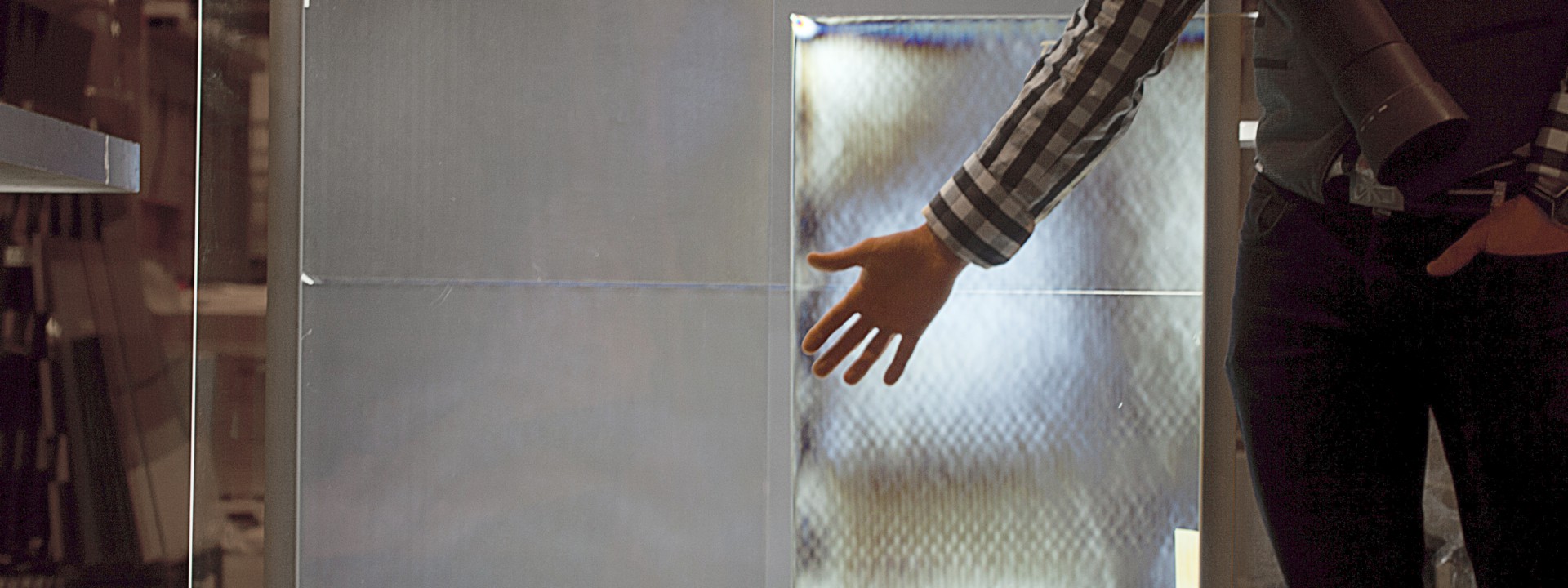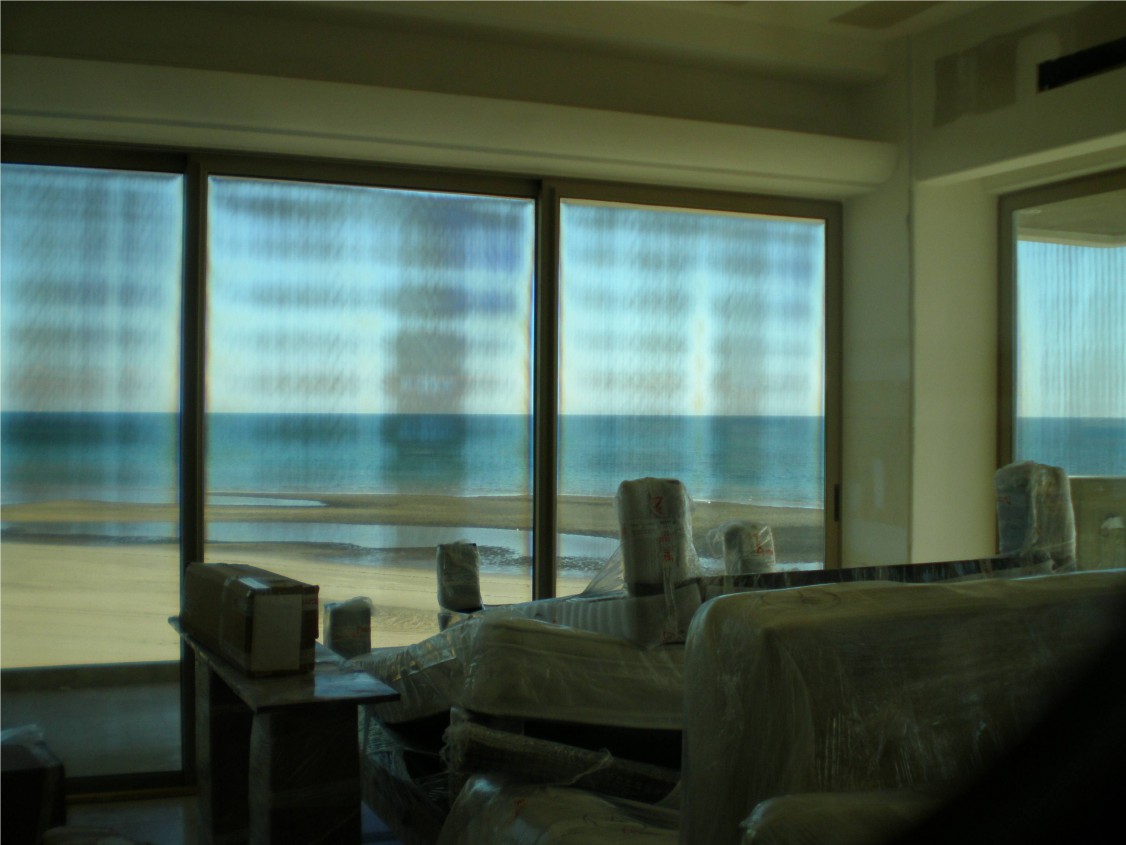
In recent years, I’ve been contacted more and more frequently by building designers with a photo of a façade with a weird stripe or pattern on it. The question I hear: “Is this acceptable and what can I do to get rid of it?”
Read more about the industry thoughts here and keep on reading this post if you want to get some actionable tips on how to get rid of it.
This phenomenon is called iridescence. Iridescence is a term for stress differences in tempered glass that become visible in certain lighting and viewing conditions. Sometimes this effect can be disturbingly visible. The phenomenon is more noticeable when:
Iridescence becomes even more visible with thick glass (8-15 mm) and with heat-strengthened glass. If the tempering process is not optimized in terms of condition, parameters and the tempering line itself, it will also affect the amount of iridescence.
Visible iridescence does not make the glass bad from a structural perspective, but it does make it look like low quality. It’s visible – and usually it should not be.

To understand how the iridescence can be minimized in a tempering line, it is crucial to understand what causes it. In short:
Iridescence is caused by uneven heating or uneven cooling in the tempering process.
This is already an important distinction. It is not only about heating, nor is it only about quenching and cooling. They both have an impact – so it is about the uniformity of both. If you heat the glass uniformly and quench the glass uniformly, you have no iridescence. However, that is only theoretical with heat-treated tempered glass.
People tend to think that iridescence is caused only by the quench. Surprisingly, the worst iridescence examples usually are caused in the heating section. So what impact does the heating then have? It has a major impact. If you create a temperature difference in the glass during the heating phase, it will stay there throughout the quench and show up as iridescence as a result. A good example of this is when local convection heating is too strong.
If you use local heating that is too strong, for example, with convection, you end up with a serious temperature difference that results in iridescence.
Quench also plays a large part in iridescence. All non-uniformity shows up as iridescence. This can be rollers conducting a cooling effect onto the glass, the quench nozzles blowing quenching air inconsistently to different parts of the glass and many other things.
Invalid Displayed Gallery
Now to the part you have all been waiting for. What you can do to minimize the iridescence in your tempered glass:
1. Identify what is causing your problem – your heating or cooling. Go back to the pictures in this post and compare these to your results. Start optimizing the process that causes the problems.
2. HEATING: Decrease your furnace temperature and increase your heating time. This will heat the glass more uniformly and increase your overall quality.
3. HEATING: Set the longest possible oscillation length. Utilize the “crawling function” in your furnace, if you have one, to minimize the stopping points. Make sure your furnace program supports alternating stopping points.
4. QUENCHING: Clean your quench nozzles. Make sure you don’t have any nozzles blocked.
5. QUENCHING: Optimize the first stopping point. Adjust your transfer speed to quench at a low level. Aim to have the first stopping point in as low temperature as possible.
As a bonus, I want to remind you to take good care of your machines. Running with broken heaters will impact your ability to heat the glass uniformly and thus your iridescence.
If you are in the process of buying a new line, make sure you have a so-called shifted design heating system with no parallel running lines to minimize this effect.
Did you find a solution to your problem?
If not, send us your question here.
注册 Glastory 快讯
我们回答您关于玻璃加工的问题。将您遇到的困难告诉我们,我们一定尽全力帮助您。
From an optics perspective, you are misusing the words “anisotropy” and “iridescence”. Like the Wikipedia article says, something is iridescent if it changes color as you change the viewing angle. Similarly, a material is anisotropic if any property of the material depends on the direction and angle. Many thin film coatings, including low-e, change color depending on whether you face them head-on or at an angle- check out http://en.wikipedia.org/wiki/Thin-film_interference for more details. With flat glass manufacturing, lots of coatings are anisotropic and iridescent yet don’t have leopard spots. This is by design, intentional, and not a defect.
Leopard spots and strain patterns, not iridescence and anisotropy, are caused by uneven heating or uneven cooling in the tempering process. If you heat parts of glass differently, you change the optical path that light takes through the glass. Optical interference causes materials to change color when you change angles, but uneven heating causes materials to change color when you change position on the glass.
Celia, great comment! Strain distribution pattern or stress distribution pattern would possibly be the most accurate terms for this phenomenon that is caused by the heat-treatment process. I’ve used anisotropy and iridescence to cover also tempered glass stress distribution pattern. Reason is that is the term used in the official standard for tempered glass. E.g. European norm for tempered glass describes:
“9.2 Anisotropy (iridescence)
The thermally toughening process produces areas of different stress in the cross section of the glass. These areas of stress produce a bi-refringent effect in the glass, which is visible in polarised light. When thermally toughened soda lime silicate safety glass is viewed in polarised light, the areas of stress show up as coloured zones, sometimes known as ‘leopard spots’. Polarised light occurs in normal daylight. The amount of polarised light depends on the weather and the angle of the sun. The bi-refringent effect is more noticeable either at a glancing angle or through polarised spectacles. Anisotropy is not a defect but a visible effect”
Anisotropy and iridescence are terms used very frequently in the processing industry (even in academic papers) to cover this phenomenon. However, I do agree that it is not the best term. Perhaps this shows how little open research we have available on glass processing? Your point about the possibility of mixing this with iridescence done on purpose e..g with a coating is very good. Would you happen to have any papers where these terms are discussed? It would be really beneficial to drive more common terminology to the whole glass industry.
Yeah, I feel you on the struggle for glass processing education. I am out of my depth a bit here, coming from a coating design background rather than glass processing. Nonetheless, I really appreciate communities for learning more about glass processing, and I enjoy the cross-talk.
I think if you added the phrase “non-uniform”, it would be ok. As in, “Non-uniform birefringence is caused by non-uniform stress from uneven heating”. Birefringence, anisotropy, and iridescence are still relevant terms, but their non-uniformity make them problematic.
Regarding low-e coatings: many suppliers put a disclaimer into their product information saying that the color depends on viewing angle. From Cardinal’s material on their LoE product, http://www.cardinalcorp.com/wp-content/uploads/pdf/cardinal-architectural-brochure.pdf :
“Viewing angle… will have a dramatic impact on the perceived glass aesthetics.”
The difference between viewing at a 5 degree and a 60 degree angle of incidence might change your visible transmission a few percent. Some examples are in this paper from Uppsala University in Sweden:
http://www.sciencedirect.com/science/article/pii/S0038092X01000196
Much effort on angle-dependent low-e color measurement is driven by the need for better thermal performance. From “Solar Thermal Technologies for Buildings: The State of the Art” by M. Santamouris: “Reliable determination of the angle-dependent optical properties of glass and glazing products is therefore essential for the accurate estimation of total solar energy gain in buildings.” He goes on to talk about how the measurement and prediction algorithms are being considered to update standards like ISO 9050 and EN 410.
The result is an on-line equipment capable of visualizing and quantifying the level of anisotropy of each single heat treated glass based on the photo-elastic theory. This allows a scientific way of quantifying the level of anisotropy.